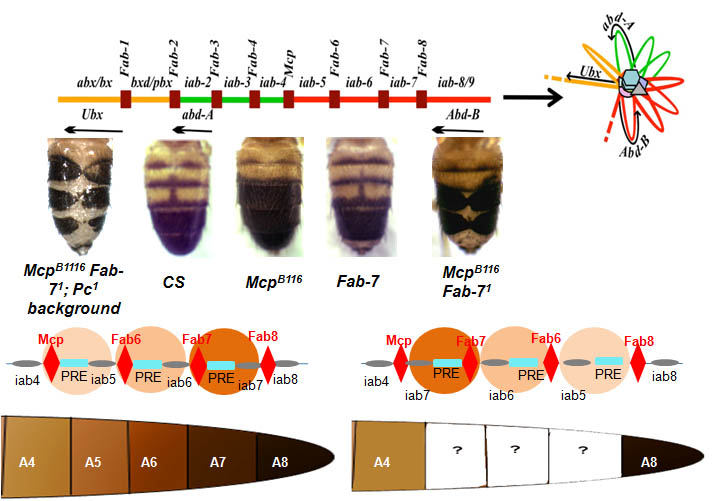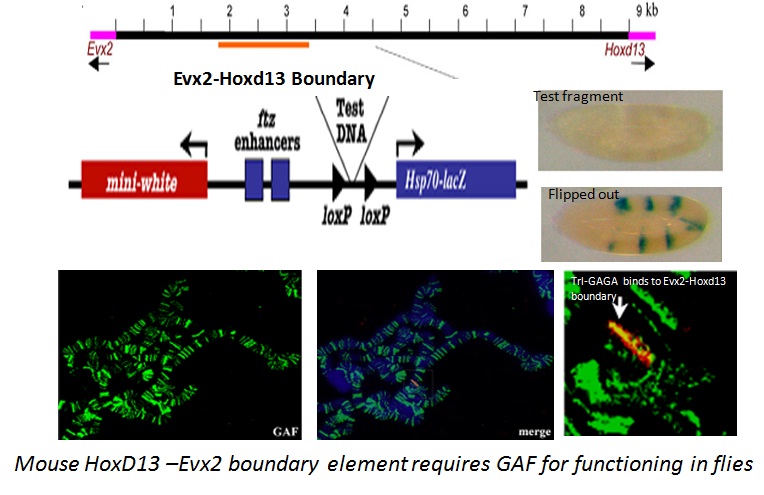Homeotic or Hox genes are evolutionarily conserved and determine the pattern of A-P body axis in all bilaterian organisms. The chromosomal arrangement of Hox genes is collinear with their expression pattern along the A-P body axis in the organism. They have been well characterized and serve as a model for our understanding of chromatin-mediated regulation of genes. We are interested in studying the molecular basis of the conserved mechanism of regulation of the Hox complexes.
I. Regulation of the Bithorax complex of Drosophila melanogaster
Homeotic genes of Drosophila exist in two clusters: the Antennapedia complex (ANT-C) and the Bithorax complex (BX-C). Collinearity of the genes in the complex with the order of body segments under their control, was first observed in Drosophila and is conserved up to vertebrates. Vertebrate hox complexes, however, are about ten times more compact as compared to those of insects. BX-C alone spans more than 300 kb, 95% of which constitutes cis regulatory regions. Remarkably though, the collinearity in the BX-C extends even to this vast cis-regulatory region.
We have adopted molecular genetic approach to study the regulation of Abd-B region of the BX-C involving higher order chromatin organization. Chromatin domain boundaries and Polycomb response elements are known to be part of this regulatory process. We are interested in understanding the molecular basis of these chromatin elements. Our result shows that combinations of boundary elements and PREs are essential for the appropriate regulation of the complex.

We find essential role of anterior Hox genes Abd-A in the domains of Abd-B where the two genes co-express. These findings contradict the rule of posterior prevalence and explain why two genes should co-express. [PLoS Genetics, 2014]
II. Evolutionarily conserved features of the vertebrate Hox complexes
The evolution and maintenance of collinear organization of Hox genes is believed to be intimately linked to the mechanism of their regulation. Furthermore, higher chromatin structure may be a key aspect of this mechanism. Our studies indicate that PRE and boundary elements are involved in the regulation of vertebrate Hox clusters too.
In mouse HoxD complex, the distinguishable temporal and spatial expression pattern of Hoxd13 and Evx2 is maintained by a chromatin domain boundary element which is functionally conserved across vertebrate species and in flies its activity is dependent on GAGA factor. [Development, 2010]

For the first time we reported a Polycomb Response Element(PRE) from a vertebrate that is functionally conserved in flies. This PRE is present upstream of mouse HoxD locus. We have shown that this mouse HoxD PRE requires PcG/trxG genes and heterochromatin components for its functioning. [Scientific Reports, 2013]

Using ChIP –chip tiling arrays at all four murine Hox clusters, we found that the histone-free intergenic regions bear GA repeat motifs and associate with the vertebrate homolog of the GAGA binding boundary factor. This suggests that they can act as GAF dependent chromatin boundaries that create independent domains, insulating each Hox gene from the influence of neighboring regulatory element. [Epigenetics Chromatin, 2013]

|









